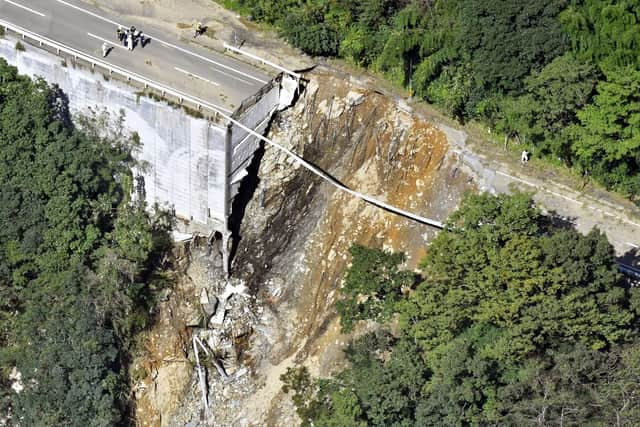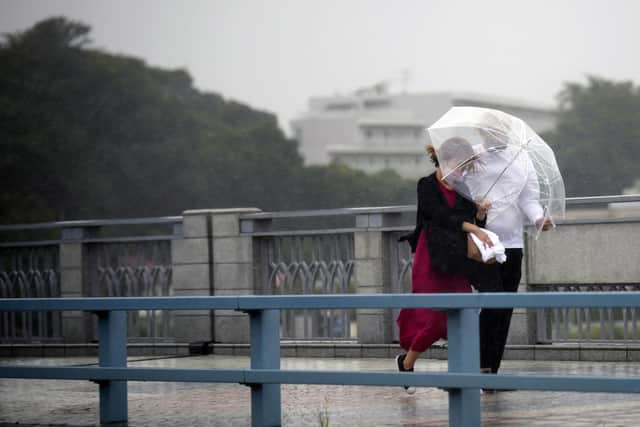Storm warning: Why climate change is providing ‘extra’ fuel for superpowered storms like ones that hit Canada, the Philippines, Japan and Puerto Rico
Five rescue workers have been killed in the Philippines after Typhoon Noru left homes flooded and millions without electricity.
Forecasters say the storm is re-strengthening and is expected to reach the coast of Vietnam by mid-week.
Advertisement
Hide AdAdvertisement
Hide AdHurricane Fiona has meanwhile been wreaking havoc on Canada, with reports of at least one death.
Rescuers have described the storm as “like nothing we've ever seen”.
Fiona also made landfall in the US territory of Puerto Rico last week, dumping almost a year’s worth of rainfall in a single day.
The vast quantity of water deposited over such a short interval caused one of its rivers to swell nearly 8m above its normal level.
All power was knocked out and a state of emergency declared.


Meanwhile, tropical storm Ian has strengthened into a hurricane that is set to unleash significant winds, flash floods and mudslides in the US state of Florida, as well as Cuba and Jamaica.
The violent storms have come shortly after the hottest summer and highest August temperatures ever recorded in Europe and amid widespread extreme heatwaves in the US and other parts of the world.
Experts have linked the increasing intensity of storms with human-induced climate change.
Advertisement
Hide AdAdvertisement
Hide Ad

Higher global temperatures are providing the extra “fuel” needed to create these blockbusting conditions, experts have claimed.
Gabi Hegerl, professor of climate system science at the University of Edinburgh’s School of Geosciences, said: “As the world gets warmer, heatwaves get more intense with it.
“The air is already moister because it’s warmer and it can hold on to more water.
“And warmer water causes the oceans to expand, driving sea level rise, which in turn means storm surges are much higher.”
She explains how hotter temperatures act as “fuel” for the most intense storms, causing heavier rainfall, and stronger winds.
Not only is the air much warmer than it used to be, she says, so are the oceans.
Air rises rapidly when heated by warm sea water, but is pushed aside as it cools by more warm air rising from below.
This cycle causes strong winds, which can whip up huge waves that can engulf large areas of land, including towns and cities.
Advertisement
Hide AdAdvertisement
Hide AdHot air has a greater capacity to absorb moisture than cold, while at the same time warmer seas allow more moisture to evaporate into the air.
This double whammy means there is more water in the sky available to fall as rain.
According to US space agency Nasa, global models predict hurricanes will likely cause more intense rainfall and have an increased coastal flood risk due to higher storm surge caused by rising seas.
Additionally, the global frequency of storms may decrease or remain unchanged, but hurricanes that form are more likely to become intense.
“As surface temperatures rise, more liquid water evaporates from the land and ocean,” wrote Angela Colbert, from Nasa’s Jet Propulsion Laboratory.
“Evaporation adds moisture to the air.
“How much water vapour the air can hold is based on its temperature.
“Warmer air temperatures can hold more water vapour.
“The increased moisture in the air leads to more intense rainfall, especially during extreme events.
“In a hurricane, spiralling winds draw moist air toward the centre, fuelling the towering thunderstorms that surround it.
Advertisement
Hide AdAdvertisement
Hide Ad“As the air continues to warm due to climate change, hurricanes can hold more water vapour, producing more intense rainfall rates in a storm.”
Several countries have been experiencing the devastating effects in recent weeks.
Japan has been hit by Typhoon Nanmadol, which killed at least four people and injured more than 100 others after making landfall on the island of Kyushu.
With winds gusting up to 145mph, homes were destroyed and businesses and transport disrupted.
Communities across a 1,000-mile stretch of Alaska's western coastline were battered by hurricane-force winds and record storm surge flooding during the most intense September storm ever recorded in the Bering Sea.
China too has suffered, after Typhoon Muifa struck Shanghai – the strongest storm to hit the city in recorded history – forcing 1.6 million people from their homes.
Meanwhile, Pakistan is still partially submerged after a super-monsoon caused unprecedented flooding that has killed close to 1,500 people.
Around 33 million people across the country have been affected by the deluge, with homes, vehicles, roads, crops and livestock destroyed and swept away.
Advertisement
Hide AdAdvertisement
Hide AdThe world’s top climate scientists have concluded catastrophic and irreversible climate destruction will occur if the planet reaches an average temperature 2C higher than in pre-industrial times.
Currently, the average global temperature rise is at around 1.2C.
But projections suggest the world is on course to be at least 2.4C hotter – possibly 4C – by the end of this century.
The landmark Paris Agreement, signed by 200 countries, sets out the joint goal of restricting the increase to 1.5C.
But action has been slow and there is concern the planet may be “locked in” to 1.5C of heating, even if emissions were to be halted immediately.
Lots of research is being carried out to investigate whether parts of the world will become uninhabitable due to excessive heat, sea level rise and flooding caused by climate change.
Prof Hegerl warns life on earth is at risk if warming is allowed to continue and stresses the importance of slashing emissions, ending fossil fuel use and employing safeguards against the worst impacts.
“Beyond 3C to 4C of warming looks quite dangerous,” she said.
Comments
Want to join the conversation? Please or to comment on this article.
